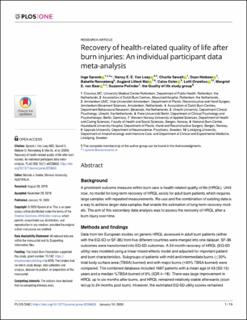| dc.contributor.author | Spronk, Inge | |
| dc.contributor.author | Van Loey, N.E.E. | |
| dc.contributor.author | Sewalt, Charlie | |
| dc.contributor.author | Nieboer, Daan | |
| dc.contributor.author | Renneberg, Babette | |
| dc.contributor.author | Moi, Asgjerd Litleré | |
| dc.contributor.author | Öster, Caisa | |
| dc.contributor.author | Orwelius, Lotti | |
| dc.contributor.author | Van Baar, M.E. | |
| dc.contributor.author | Polinder, Suzanne | |
| dc.date.accessioned | 2020-03-30T13:17:34Z | |
| dc.date.available | 2020-03-30T13:17:34Z | |
| dc.date.created | 2020-01-26T14:12:26Z | |
| dc.date.issued | 2020 | |
| dc.identifier.citation | Spronk, I., Van Loey, N. E. E., Sewalt, C., Nieboer, D., Renneberg, B., Moi, A. L., . . . Polinder, S. (2020). Recovery of health-related quality of life after burn injuries: An individual participant data meta-analysis. Plos One, 15(1). | en_US |
| dc.identifier.issn | 1932-6203 | |
| dc.identifier.uri | https://hdl.handle.net/11250/2649430 | |
| dc.description.abstract | Background
A prominent outcome measure within burn care is health related quality of life (HRQL). Until now, no model for long-term recovery of HRQL exists for adult burn patients which requires large samples with repeated measurements. Re-use and the combination of existing data is a way to achieve larger data samples that enable the estimation of long-term recovery models. The aim of this secondary data analysis was to assess the recovery of HRQL after a burn injury over time.
Methods and findings
Data from ten European studies on generic HRQL assessed in adult burn patients (either with the EQ-5D or SF-36) from five different countries were merged into one dataset. SF-36 outcomes were transformed into EQ-5D outcomes. A 24-month recovery of HRQL (EQ-5D utility) was modeled using a linear mixed-effects model and adjusted for important patient and burn characteristics. Subgroups of patients with mild and intermediate burns (≤20% total body surface area (TBSA) burned) and with major burns (>20% TBSA burned) were compared. The combined database included 1687 patients with a mean age of 43 (SD 15) years and a median %TBSA burned of 9% (IQR 4–18). There was large improvement in HRQL up to six months after burns, and HRQL remained relatively stable afterwards (studied up to 24 months post burn). However, the estimated EQ-5D utility scores remained below the norm scores of the general population. In this large sample, females, patients with a long hospital stay and patients with major burns had a delayed and worse recovery. The proportion of patients that reported problems for the EQ-5D dimensions ranged from 100% (pain/discomfort at baseline in patients with major burns) to 10% (self-care ≥3 months after injury in patients with mild and intermediate burns). After 24 months, both subgroups of burn patients did not reach the level of the general population in the dimensions pain/discomfort and anxiety/depression, and patients with major burns in the dimension usual activities. A main limitation of the study includes that the variables in the model were limited to age, gender, %TBSA, LOS and time since burn as these were the only variables available in all datasets.
Conclusions
The 24-month recovery model can be used in clinical practice to inform patients on expected HRQL outcomes and provide clinicians insights into the expected recovery of HRQL. In this way, a delayed recovery can be recognized in an early stage and timely interventions can be started in order to improve patient outcomes. However, external validation of the developed model is needed before implementation into clinical practice. Furthermore, our study showed the benefit of secondary data usage within the field of burns. | en_US |
| dc.language.iso | eng | en_US |
| dc.publisher | PLoS | en_US |
| dc.rights | Navngivelse 4.0 Internasjonal | * |
| dc.rights.uri | http://creativecommons.org/licenses/by/4.0/deed.no | * |
| dc.subject | burn management | en_US |
| dc.subject | burns | en_US |
| dc.subject | surgical and invasive medical procedures | en_US |
| dc.subject | hospitals | en_US |
| dc.subject | etiology | en_US |
| dc.subject | patients | en_US |
| dc.subject | quality of life | en_US |
| dc.subject | young adults | en_US |
| dc.title | Recovery of health-related quality of life after burn injuries: An individual participant data meta-analysis | en_US |
| dc.type | Peer reviewed | en_US |
| dc.type | Journal article | en_US |
| dc.description.version | publishedVersion | en_US |
| dc.rights.holder | © 2020 Spronk et al. | en_US |
| dc.source.journal | PLOS ONE | en_US |
| dc.identifier.doi | 10.1371/journal.pone.0226653 | |
| dc.identifier.cristin | 1782191 | |
| cristin.ispublished | true | |
| cristin.fulltext | original | |
| cristin.qualitycode | 1 | |

